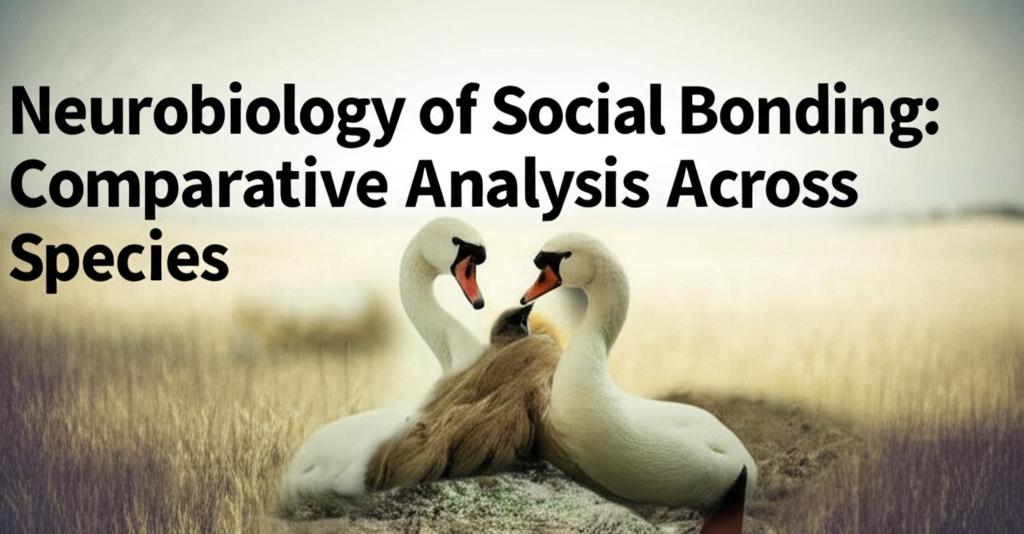Social bonding, a fundamental aspect of the lives of many species, from insects to humans, involves complex neurobiological mechanisms that ensure the formation and maintenance of social relationships. These bonds, whether between parent and offspring, mates, or other group members, are crucial for survival and reproduction. While the expression of social bonding varies considerably across the animal kingdom, comparative research reveals fascinating commonalities and species-specific adaptations in the underlying neural and hormonal pathways.
At the core of social bonding are neuropeptides, particularly oxytocin and vasopressin. These ancient molecules, and their non-mammalian homologues like isotocin and vasotocin, play a pivotal role in regulating various social behaviors across diverse species. In mammals, oxytocin is strongly implicated in maternal bonding, promoting nurturing behaviors, social recognition, and the formation of mother-infant attachments. Vasopressin, especially in males, is often linked to pair bonding, mate guarding, territoriality, and aggression towards intruders. Studies in monogamous species like prairie voles have been particularly insightful, demonstrating that the density and distribution of oxytocin and vasopressin receptors in specific brain regions are critical for the formation of enduring pair bonds. For instance, higher concentrations of these receptors in reward-related brain areas are associated with stronger bonding. Interestingly, even in non-mammalian species like fish, analogous neuropeptides and their receptors are involved in regulating social affiliation and pair bonding behaviors, suggesting a deep evolutionary conservation of these systems.
The brain's reward system, orchestrated largely by dopamine, is another critical component in the neurobiology of social bonding. Positive social interactions, such as grooming, mating, or parental care, activate dopaminergic pathways, reinforcing these behaviors and associating them with specific individuals. In prairie voles, the interaction between oxytocin/vasopressin and dopamine systems in brain regions like the nucleus accumbens is essential for linking the rewarding aspects of social contact with the recognition of a particular partner, thereby facilitating bond formation. Comparative studies indicate that while the specific behaviors and sensory cues involved in bonding may differ, the recruitment of reward pathways to solidify social connections appears to be a widespread strategy across species.
Brain regions consistently implicated in social bonding across various species include the amygdala, prefrontal cortex, hypothalamus (particularly the paraventricular nucleus, a major site of oxytocin and vasopressin production), nucleus accumbens, and ventral pallidum. These areas are part of a larger "social brain network" that processes social cues, evaluates their emotional significance, and motivates appropriate social responses. Comparative neuroanatomical studies reveal that while the overall architecture of these regions is conserved, species-specific variations in their connectivity and neurochemical sensitivity likely contribute to the diversity of social structures and bonding patterns observed in nature. For example, the complexity of maternal and pair-bonding behaviors in primates, including humans, is thought to be supported by more elaborate and flexible neural circuitry shaped by early life experiences, though the fundamental mechanisms are likely shared with other mammals.
Gene expression studies comparing closely related species with differing social systems, such as monogamous prairie voles and non-monogamous meadow voles, have identified numerous genes beyond those directly coding for oxytocin, vasopressin, and their receptors that contribute to bonding capacity. These genes are involved in a wide array of functions, including neuronal structure, synaptic plasticity, and transcriptional regulation, highlighting the multifaceted genetic basis of social bonding. Epigenetic modifications, influenced by early life experiences such as parental care, can also significantly impact the expression of these genes and, consequently, adult social behavior and bonding capabilities. This interplay between genes and environment underscores the plasticity of the neurobiological systems underlying social bonds.
Furthermore, the communication of emotional states, often involving synchronized neural activity between interacting individuals, is a relevant aspect across species. Even in rodents, phenomena like emotional contagion and consolation behaviors have been observed, suggesting primitive forms of empathy that likely support social cohesion. In some species, intricate social interactions actively coordinate behaviors like biparental care over longer timescales.
In summary, the neurobiology of social bonding is a rich and evolving field. Comparative analyses across species reveal a fascinating tapestry of conserved core mechanisms, primarily involving neuropeptides like oxytocin and vasopressin and the brain's reward circuitry, alongside species-specific adaptations that give rise to the remarkable diversity of social lives on Earth. Understanding these intricate neural underpinnings not only offers insights into the evolution of sociality but also holds potential for addressing social deficits in various human conditions.

